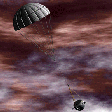 |
Galileo Probe Suggests Planetary Science Reappraisal
(January 22, 1996)
| Galileo Probe Suggests Planetary Science Reappraisal(January 22, 1996) |
Preliminary analysis of early data returned by NASA's historic Galileo probe mission into Jupiter's atmosphere has provided a series of startling discoveries for project scientists.
Information on the extent of water and clouds and on the chemical composition of the Jovian atmosphere is particularly revealing. Probe instruments found the entry region of Jupiter to be drier than anticipated, and they did not detect the three-tiered cloud structure that most researchers had postulated. The amount of helium measured was about one-half of what was expected.
These initial findings are encouraging scientists to rethink their theories of Jupiter's formation and the nature of planetary evolution processes, according to probe project scientist Dr. Richard Young of NASA's Ames Research Center, Mountain View, CA.
"The quality of the Galileo probe data exceeds all of our most optimistic predictions," said Dr. Wesley Huntress, NASA Associate Administrator for Space Science. "It will allow the scientific community to develop valuable new insights into the formation and evolution of our solar system, and the origins of life within it."
The probe made the most difficult planetary atmospheric entry ever attempted, according to probe manager Marcie Smith of NASA Ames. Entering Jupiter's atmosphere on Dec. 7, 1995, it survived entry speeds of over 106,000 mph, temperatures twice those on the surface of the Sun and deceleration forces up to 230 times the strength of gravity on Earth. It relayed data obtained during its 57-minute descent mission back to the Galileo orbiter more than 130,000 miles overhead for storage and transmission to Earth. The orbiter is now embarking on a two-year mission to study Jupiter and its moons.

| 
| 
|
| Probe Mission Summary
(GIF, 38K; JPEG, 51K) | Probe Mission Performance
(GIF, 37K; JPEG, 59K) | General Probe Mission
(GIF, 35K; JPEG, 43K) |
"The probe detected extremely strong winds and very intense turbulence during its descent through Jupiter's thick atmosphere. This provides evidence that the energy source driving much of Jupiter's distinctive circulation phenomena is probably heat escaping from the deep interior of the planet," Young said. "The probe also discovered an intense new radiation belt approximately 31,000 miles above Jupiter's cloud tops, and a veritable absence of lightning."

| 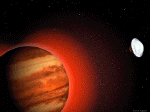
| 
|
| Doppler Wind Experiment
(GIF, 30K; JPEG, 28K) | Radiation Belt
(GIF, 42K; JPEG, 289K) | Radiation Fluxes
(GIF, 29K) |
The composition of Jupiter's atmosphere offered some surprises, according to project scientists. It contains significantly lower-than-expected levels of helium, neon, and certain heavy elements, such as carbon, oxygen and sulfur.

| 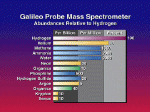
|
| Structure of Jupiter's Atmosphere
(GIF, 29K; JPEG, 33K) | Mass Spectrometer
(GIF, 34K; JPEG, 40K) |
The issue of the colors of Jupiter's atmosphere has been much-debated, but no consensus has developed from probe data to date. The probe encountered no solid objects or surfaces during it's entire 373-mile (600 km) journey. This was as expected for a gas-giant planet such as Jupiter.
What are the implications of these findings? Most scientists believe that Jupiter has a bulk composition similar to that of the gas and dust cloud of the primitive solar nebula from which the planets and our Sun were formed, with added heavy elements from comets and meteorites. The probe's measurements may necessitate a re-evaluation of existing views of how Jupiter evolved from the solar nebula. For example, the lower-than-expected helium and neon levels on Jupiter relative to the Sun influence scientific understanding of the process of fractionation, the "raining out" of helium and neon during planetary evolution.
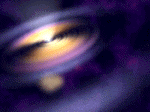
| 
|
| Solar System & Jupiter formation
(GIF, 48K; JPEG, 453K) | Helium: A tracer for planetary evolution
(GIF, 38K; JPEG, 39K) |
During the probe's high-speed, atmospheric-entry phase, deceleration measurements high in the atmosphere showed atmospheric density to be much greater than expected. Corresponding temperatures were also much higher than predicted. The high temperatures appear to require an unidentified heating mechanism for this region of the atmosphere.
Following probe parachute deployment, six science instruments on the probe collected data throughout 97 miles (156 km) of the descent. During that time, the probe endured severe winds, periods of intense cold and heat and strong turbulence. The extreme temperatures and pressures of the Jovian environment eventually caused the probe communications subsystem to terminate data transmission operations.
Earth-based telescopic observations suggest that the probe entry site may well have been one of the least cloudy areas on Jupiter. At this location, the probe did not detect the three distinct layers of clouds (a topmost layer of ammonia crystals, a middle layer of ammonium hydrosulfide, and a final, thick layer of water and ice crystals) that researchers had anticipated.
Some indication of a high-level ammonia ice cloud was detected by the net flux radiometer. Evidence for a thin cloud which might be the postulated ammonium hydrosulfide cloud was provided by the nephelometer experiment. There was no data to suggest the presence of water clouds of any significance. The vertical temperature gradient obtained by the atmospheric structure instrument was characteristic of a dry atmosphere, free of condensation. Only the one, distinctive cloud structure was identified, and that was of modest proportion.
The latest analyses of data from the Voyager spacecraft that flew by Jupiter in 1979 had suggested a water abundance for the planet of twice the solar level (based on the Sun's oxygen content). Observations of the propagation of atmospheric waves across Jupiter's cloud tops from the Comet Shoemaker-Levy 9 impacts implied that Jupiter might have a water content of ten times the solar level. Actual probe measurements, while subject to scientific debate, suggest a level near that of the Sun. Scientists are left to wonder, "where is the oxygen?," "where is the water?," and to reconsider their interpretation of the S-L 9 impacts.
Scientists had expected to find severe winds on Jupiter ranging up to 220 mph. However, the probe appears to have detected winds far greater, perhaps up to 330 mph. The winds remained fairly constant as the probe descended deep into the Jovian atmosphere. This suggests that Jupiter's winds are not caused by differential sunlight at the equator versus the poles or by heat released by water condensation as on Earth, according to project scientists.
"The origin of Jupiter's winds appears to be the internal heat source which radiates energy up into the atmosphere from the planet's deep interior," Young said. "This impacts Jupiter's climate and circulation patterns, and suggests a jet stream-like mechanism rather than swirling hurricane or tornado-like storms."
The probe found that lightning occurs on Jupiter only about one-tenth as often as on Earth. This is puzzling, but consistent with the absence of water clouds. A virtual absence of lightning reduces the probability of finding complex organic molecules in Jupiter's atmosphere, particularly given its hostile, predominantly hydrogen composition.
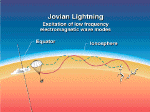
|
| Jovian Lightning
(GIF, 26K; JPEG, 31K) |
Scientists caution that results obtained to date, while dramatic and exciting, are only preliminary and subject to much further analysis and refinement. Data transmission problems associated with solar conjunction between the Earth and Jupiter, the need to refine estimates based on probe and orbiter trajectories, the presence of higher than anticipated instrument temperatures, and the need for improved calibration all require a cautious approach to these early findings.
Additional information will be forthcoming over the next few months as scientists continue to evaluate the wealth of data obtained by the probe and to cross-compare results of individual scientific instruments. Further information and images about the Galileo mission to Jupiter can be accessed on the Internet through the following three URLs:
http://ccf.arc.nasa.gov/dx
http://ccf.arc.nasa.gov/galileo_probe/
and
http://www.jpl.nasa.gov/galileo
The Galileo probe project is managed by NASA's Ames Research Center, Mountain View, CA. Hughes Aircraft Co., El Segundo, CA, designed and built the probe; General Electric, Philadelphia, PA, built the probe's heat shield. NASA's Jet Propulsion Laboratory, Pasadena, CA, built the Galileo orbiter spacecraft and manages the overall mission.
David Morse, January 22, 1996
Ames Research Center, Mountain View, CA, Embargoed until 10 a.m. PST
(Phone: 415/604-4724)
RELEASE: 96-04